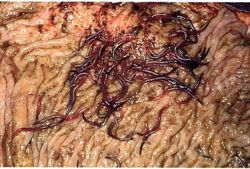Strongyles - Large - Donkey
Introduction
Large strongyles

The common large strongyle species infecting equids are Strongylus vulgaris, S.edentatus and S. equinus. Similar species are observed in horses and donkeys. A new species, Strongylus asini, has been seen in donkeys and other wild equids. Triodontophorus spp., some Craterostomum spp., and Oesophagodontus robustus are also in this group.
- S. vulgaris are pathogenic due to damage caused by vascular migration
- A study in Zimbabwe has shown that the intensities of infection of adults in the large intestine and larvae in the cranial mesenteric artery and its branches were much higher than those recorded in horses (Pandey and Eysker, 1989)
- S. edentatus migrates through the liver and peritoneum, causing associated damage
Similar pathogenic effects of S. vulgaris in donkeys to those found in horses have been reported. In donkeys, various lesion types have been recorded. These include minimal arterial lesions, small thrombi and substantial thrombi, the size of a tennis ball, where the arterial wall is greatly thickened, corrugated, gritty and full of larvae. These arterial lesions, which can interfere with the blood supply to major parts of the alimentary tract, may be one of the major contributory factors for the weakness, low productivity and early demise of working donkeys.
|
|
This section was sponsored and content provided by THE DONKEY SANCTUARY |
|---|